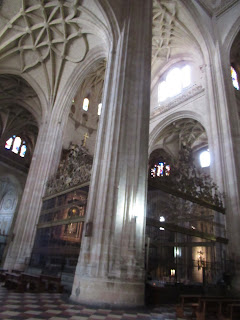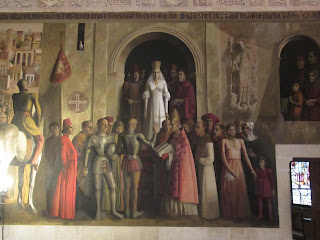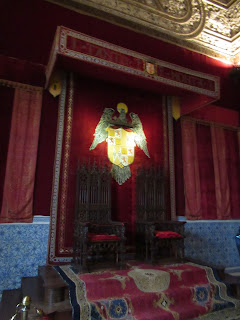We'd spent the previous couple of days touring the fascinating sights around Segovia, the city northwest of Spain's capital city of Madrid. Its emblematic sight was its Roman aqueduct that we'd just driven by up until that point. When Segovia was a Roman military base, it needed water. Emperor Trajan's engineers built a nine-mile aqueduct from the Rio Frio ending at the Roman castle, now the Alcazar.
From the square, we ventured along the Calle de Cervantes or Street of Cervantes, named after the famous Spanish writer who wrote Don Quixote, and is considered the greatest writer in the Spanish language.
Interesting sights on the Calle de Cervantes:
I loved the cute back to back benches on the square! To walk around the streets in the Old Town was a pleasure as well as a history lesson!
I read that the Alcazar was supposed to be one of the inspirations for the castle at Disneyland which made sense as it really looked like a fairy-tale castle. But when the Alcazar of today was rebuilt after a major fire in the 1800s, it became a Disneyesque exaggeration of the original.
The Mudejar-style doorway to the Royal Bedroom:
The famous section of the 2,000 year-old aqueduct that still remained was 2,500 feet long, 100 feet high with 118 arches made from 20,000 granite blocks without any mortar! It seemed almost mind-boggling that it still could carry a stream of water to this day and that it actually functioned until the late 19th century.
We had a spectacular sense of its grandeur from the city's massive Plaza del Azoguejo. In the middle of one of the arches was a religious statue.
From the square, we ventured along the Calle de Cervantes or Street of Cervantes, named after the famous Spanish writer who wrote Don Quixote, and is considered the greatest writer in the Spanish language.
We came to the unusual Casa de los Picos or House of a Thousand Beaks. On the side, we could make out the building's truncated tower, one of many fortified towers that marked the homes of feuding local noble families, according to travel writer Rick Steves.
In the 15th century, as King Ferdinand and Queen Isabella centralized authority in Spain, nobles were required to lop off their towers. Another example of a similar once-fortified house with a cropped tower was just down the street in tiny Plaza del Platero Oquendo.
I was drawn to what I thought then was the unusual design on the building, not realizing we'd soon come across many more intriguing designs on the exteriors of homes and buildings.
In the large Plaza de San Martin was the statue of Juan Bravo. When Charles V, a Habsburg who didn't even speak Spanish, took power, he imposed control over Castile. That threatened the local nobles, so, inspired and led by Juan Bravo, they revolted in 1521. Although Bravo lost the battle and his life, he has remained a symbol of Castilian pride. The statue was erected in 1921 on the 400th anniversary of his death.
A couple of homes in the square had the similar decorative stucco work we'd just admired with Arabic-style floral and vivid geometrical patterns.
On the same square was the 12th century Segovian Romanesque-style Church of San Martin which meant it was a combination of Christian Romanesque and Moorish styles.
Just up the street was the Corpus Christi Convent, a Franciscan church that was once a synagogue, and, before that a mosque! Unfortunately, it was closed so we could only view the exterior and courtyard.
As we headed to Segovia's Plaza Mayor, we couldn't help but admire more wonderful stucco decorations on buildings including one with a lacy design.
The Plaza was once the place where executions, religious theater and bullfights took place. When the latter ended in the 19th century, the people of Segovia were able to enjoy a gentler form of entertainment with bands in the gazebo.
Segovia's City Hall was the focal point of the square. Atop it was the depiction of the aqueduct, Segovia's symbol.
Opposite City Hall was the Renaissance Church of San Miguel built to replace the church where Isabella was proclaimed Queen of Castile in 1474.
Also on the square was Theater Juan Bravo with another symbol of the aqueduct.
I loved the cute back to back benches on the square! To walk around the streets in the Old Town was a pleasure as well as a history lesson!
Not far away was Segovia's Cathedral, Spain's last major Gothic building when it was built from 1525-1768. Its flying buttresses were a great example of the final late Gothic style called Flamboyant.
Behind the wrought iron grill was the impressive main altar.
Again, we could only peek at the choir through the gates. In between the altar and the choir were many tombs but we'd sort of grown accustomed by then to walking on tombs!
The choir featured finely carved wooden stalls from the 1400s!
In the middle of the choir was a large stand for choir books. In the rear was the bishop's chair.
Many of the side chapels were 16th century and came with big locking gates which was a reminder that they were the private sacred domain of the rich families and guilds who 'owned' them. There they could attend private Masses with their names actually spoken in the blessings and have a burial spot close to the altar!
The back of the choir was just as, if not more, attractive than its front.
The Chapel of the Conception looked like a small art gallery with its many 17th century paintings hanging behind a mahogany wood gate from colonial America.
The center statue was of Mary of the Apocalypse, as described in the bible's Book of Revelations, standing on a devil and half-moon which looked like bull's horns. Mary was depicted as being pregnant with the devil licking his evil chops and waiting to devour the baby Messiah.
One of the strangest paintings I'd ever seen in a church was The Tree of Life, also in the Chapel, which depicted hedonistic mortals dancing atop the Tree of Life! Rick Steves described the skeletal Grim Reaper preparing to receive them into Hell by literally chopping down the tree while Jesus rang a bell imploring them to wake up before it was to late.
It was a beautiful cathedral, and very typical of many Spanish churches and cathedrals with a mixture of styles through many different cultures. Dedicated to the Virgin Mary, this stunning, soaring, imposing yet light architectural masterpiece was recognized as an UNESCO World Heritage Site.
We walked along the narrow, winding lanes of the city's former Jewish Quarter on our way to the Alcatraz.
The 1817 Ferdinand and Isabella Gate at the entrance to the Alcatraz, the fortified palace that was one of the favorite residences during the Middle Ages of the monarchs of Castile, as well as a key fortress for defending the region.
Views of the walls from the Alcatraz:
I was amazed seeing this impressive tapestry in the ticket office!
The first written record of the Alcazar was from the beginning of the 13th century.
When I had to go downstairs to use the bathroom, I noticed the cellars' Roman foundations.
Seeing the military displays reminded me the Alcazar had once been the Royal Artillery School.
The sumptuous ceilings were restored in the Mudejar style, i.e strongly influenced by Moorish taste and workmanship.
The windows gave us breathtaking views of Segovia.
A view of the Vera Cruz Church built by the Knights Templar that we'd visited the previous morning:
The big mural showed Queen Isabella the Catholic being proclaimed Queen of Castile and Leon in Plaza Mayor in 1474.
I don't recall ever looking up at such gorgeous ceilings in any other place as I did while touring the Alcazar!
The Pine Cone Room was named after the peculiar 392 pine cone carvings on its molded ceilings.
The impressive Throne Room:
The Hall of the Monarchs was lined with the busts of the 52 rulers of Castile and Leon who presided during the Reconquista in medieval Spain, a series of campaigns spanning almost 800 years by Christian states to recapture territory from the Moors, who had occupied most of the Iberian Peninsula in the early 8th century.
More bucolic views of the countryside around Segovia:
The Cord Room was named after the Franciscan cord adorning its walls which, according to a legend, was fitted by order of Alfonso X the Wise as a sign of penance for his excessive pride.
Through this small opening, we were able to peek into the Chapel.
In the Chapel oddly enough was a painting of St. James the Moor Slayer with Muslim heads literally rolling at his feet! James is the patron saint of Spain. His name was the rallying cry in the Christian crusade to push the Muslim Moors back to Africa.
We were fortunate the terrace, the site of the original Roman military camp, was open as it was closed on windy days and in the winter.
How much fun it would have been to wander through the maze garden below!
From the terrace, we could marvel at the natural fortification provided by the promontory cut by the confluence of two rivers.
The Armoury held a vast collection of weapons from different eras.
The Armoury Courtyard:
Pretty impressive cannon outside the Military School!
The Alcazar was absolutely amazing, with each room a marvel, with fascinating walls, ceilings and stained-glass windows.
We wanted one last closer look at the aqueduct so walked through the desolated Jewish Quarter again.
The Roman Aqueduct was added to the UNESCO World Heritage List in 1985.
Two of my enduring and favorite memories of our entire trip to Spain are the Aqueduct and the lovely stucco designs we saw on so many buildings.
Next post: Exploring marvelous Madrid.
Posted on January 5th, 2019, from our home in suburban Denver.




























































































































The Roman Aqueduct is amazing. Janina
ReplyDeleteI couldn't agree with you more, Janina. You can see why I considered it to be one of our highlights in Spain.
ReplyDelete